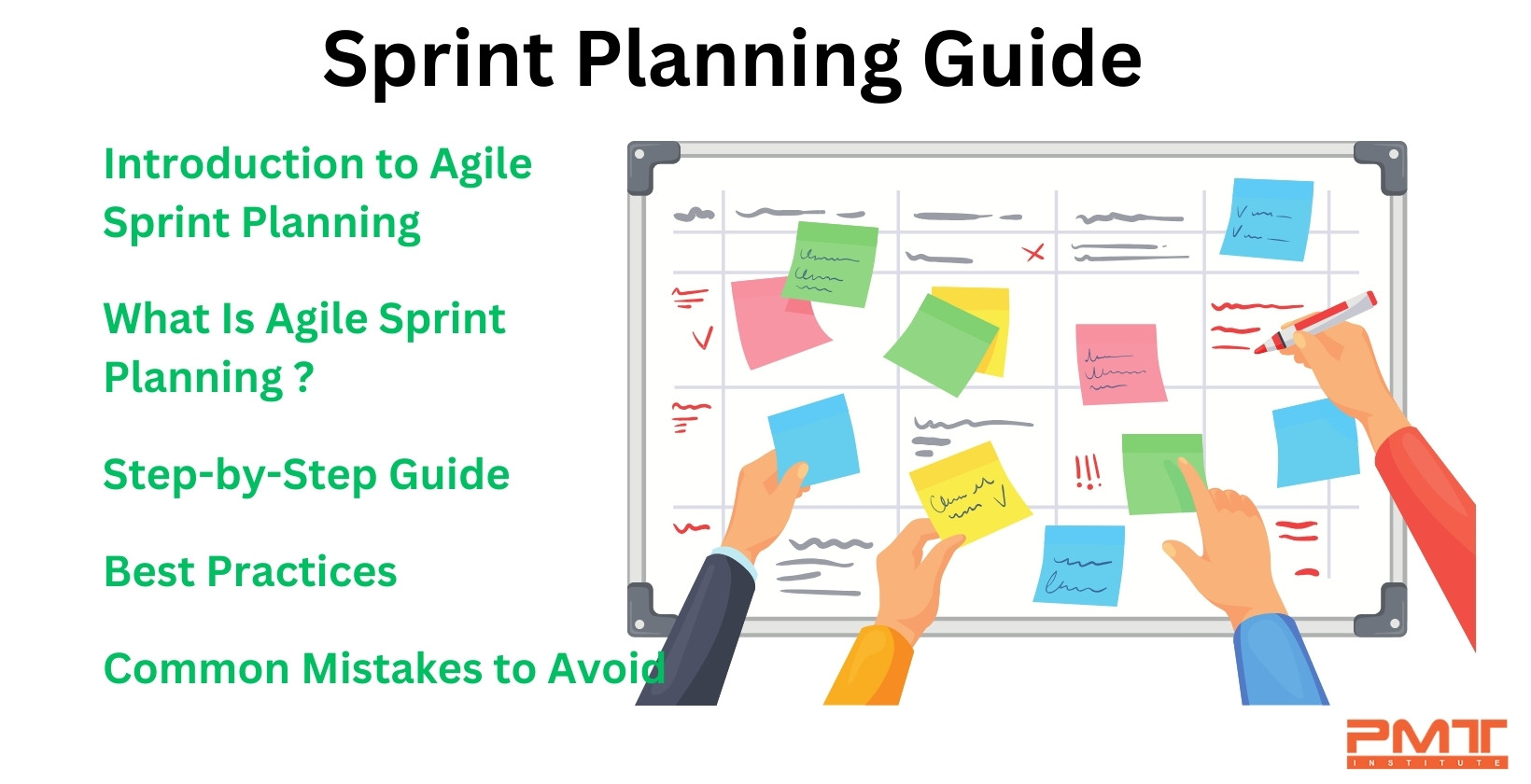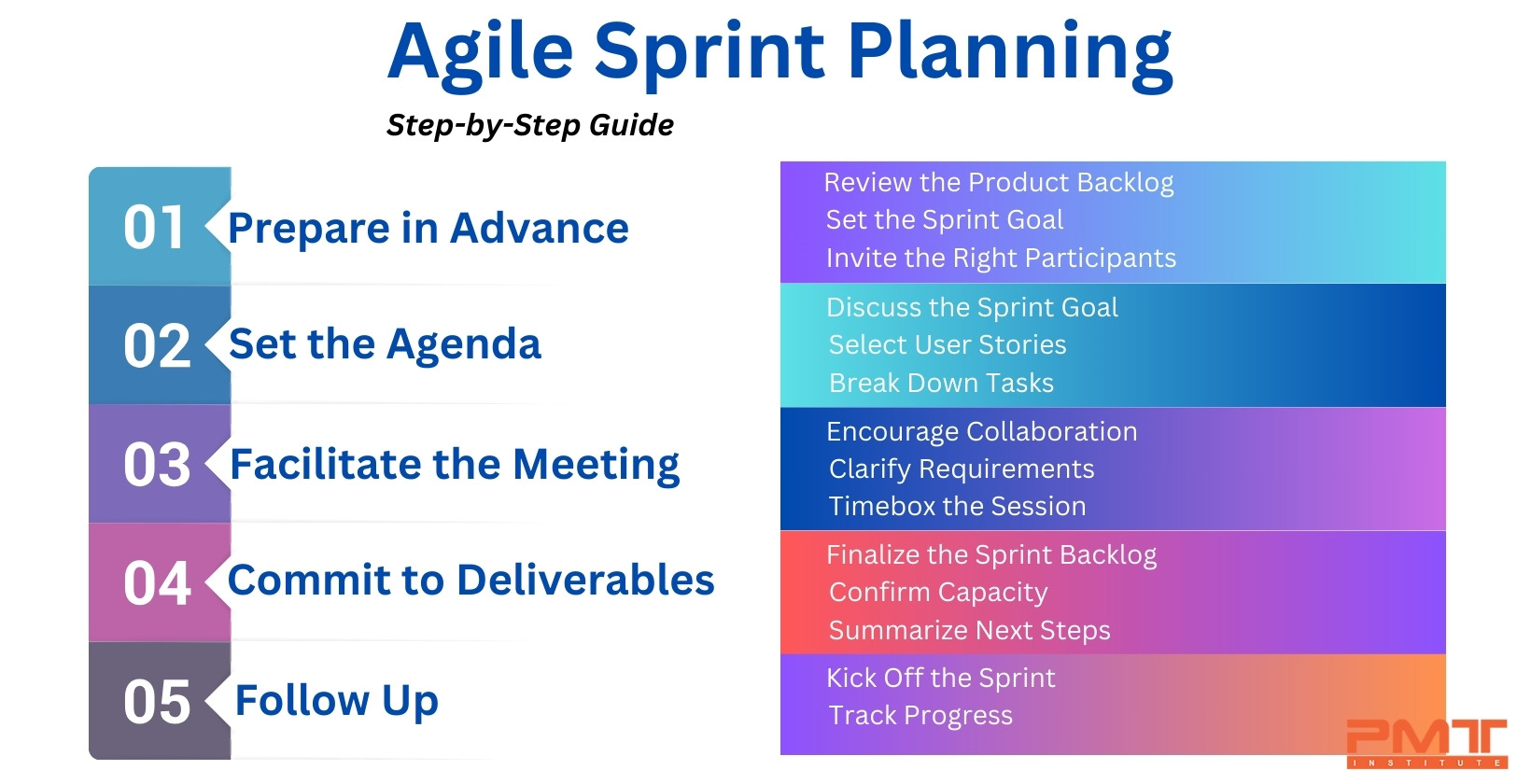Agile Sprint Planning: A Step-by-Step Guide for Success in 2025
Published:
Updated:

Introduction to Agile Sprint Planning
Agile sprint planning is one of the most critical ceremonies in Scrum and other Agile frameworks. It sets the tone for the upcoming sprint by defining what the team will deliver and how they will achieve it. A well-executed sprint planning session ensures that the team is aligned, focused, and prepared to deliver value incrementally.
However, many teams struggle with sprint planning due to unclear goals, poor prioritization, or lack of collaboration. In this guide, we’ll walk you through a step-by-step process for conducting effective sprint planning meetings. You’ll learn how to prepare, structure, and facilitate the session to maximize productivity and alignment.
For a broader overview of Agile frameworks, check out our pillar post: The Ultimate Guide to Agile Project Management Methodology.
Key Takeaways
- Prepare in advance : Ensure the backlog is refined and the sprint goal is clear.
- Set a clear agenda : Structure the meeting to focus on goals, user stories, and task breakdowns.
- Facilitate effectively : Encourage collaboration and keep the session timeboxed.
- Use tools and templates : Leverage tools like Jira, Trello, or Asana to manage and track sprint plans.
- Follow up : Monitor progress and adjust as needed to ensure success.
What Is Agile Sprint Planning?
Sprint planning is a collaborative event where the Scrum Team determines the work to be completed during the upcoming sprint. It ensures that all team members have a clear understanding of their priorities and goals, setting the foundation for a successful sprint.
Participants in Sprint Planning
- Product Owner: Prioritizes the backlog and clarifies requirements.
- Development Team: Estimates effort and commits to delivering the sprint goals.
- Scrum Master: Facilitates the meeting and ensures adherence to Agile principles.
Key Objectives of Sprint Planning
During sprint planning, the team collaborates to achieve the following:
- Define the Sprint Goal: Establish a clear objective for the sprint.
- Select User Stories: Identify which backlog items will be included in the sprint.
- Plan Execution: Break down user stories into tasks and assign ownership.
- Commit to Deliverables: Ensure the team agrees on what can realistically be achieved.
Why Is Sprint Planning Important?
Sprint planning plays a critical role in Agile development for several reasons:
- Shared Understanding: It ensures that the entire team aligns on the work to be done.
- Prevents Scope Creep: By clearly defining deliverables, sprint planning helps keep the team focused on the planned objectives.
- Enhances Predictability: By estimating effort and committing to deliverables, teams can improve their sprint velocity.
- Boosts Team Collaboration: The planning session fosters discussions that improve clarity and teamwork.
By conducting effective sprint planning, teams can enhance productivity, improve delivery timelines, and maximize the value they deliver to stakeholders.
Step-by-Step Guide to Agile Sprint Planning
Running an effective sprint planning session requires careful preparation and execution. Below is a step-by-step guide to help you structure the meeting for maximum efficiency.

Step 1: Prepare in Advance
- Review the Product Backlog: Ensure the backlog is refined and prioritized before the meeting.
- Set the Sprint Goal: Collaborate with the Product Owner to define a clear and achievable sprint goal.
- Invite the Right Participants: Include the Product Owner, Development Team, and Scrum Master.
Step 2: Set the Agenda
- Welcome and Objectives: Start by welcoming participants and outlining the purpose of the meeting.
- Discuss the Sprint Goal: Present the sprint goal and align the team around it.
- Select User Stories: Review the prioritized backlog and select stories for the sprint based on capacity.
- Break Down Tasks: Decompose user stories into smaller tasks and estimate effort using techniques like story points or hours.
Step 3: Facilitate the Meeting
- Encourage Collaboration: Foster open discussion and ensure everyone has a voice.
- Clarify Requirements: The Product Owner should answer questions and clarify acceptance criteria.
- Timebox the Session: Limit the meeting to 2–4 hours, depending on the sprint length.
Step 4: Commit to Deliverables
- Finalize the Sprint Backlog: Document the selected user stories and tasks in the sprint backlog.
- Confirm Capacity: Ensure the workload aligns with the team’s capacity and velocity.
- Summarize Next Steps: Recap the sprint goal, deliverables, and individual responsibilities.
Step 5: Follow Up
- Kick Off the Sprint: Hold a quick kickoff meeting to address any last-minute questions.
- Track Progress: Use tools like burndown charts or Kanban boards to monitor progress throughout the sprint.
By following this structured approach to sprint planning, teams can ensure alignment, improve efficiency, and maximize value delivery during each sprint cycle.
Best Practices for Agile Sprint Planning
To ensure your sprint planning sessions are productive and engaging, follow these best practices:
Start with a Clear Sprint Goal
The sprint goal provides focus and direction for the team. It serves as a guiding principle that helps prioritize tasks and ensures alignment with the overall product roadmap.
Refine the Backlog Regularly
Backlog refinement is a continuous process that ensures user stories are well-defined, prioritized, and ready for sprint planning. This helps the team avoid unnecessary delays and confusion during the planning session.
Involve the Entire Team
Encourage participation from all team members to foster ownership and accountability. Sprint planning is not just for developers—Product Owners, testers, and designers should actively contribute to discussions and decision-making.
Use Estimation Techniques
Accurate estimation is key to successful sprint planning. Leverage techniques like:
- Planning Poker: A collaborative estimation method where team members assign effort scores to user stories using a deck of cards.
- T-Shirt Sizing: A relative estimation technique where tasks are categorized as Small, Medium, Large, or Extra Large based on complexity.
Be Realistic About Capacity
Avoid overcommitting by considering the team’s velocity and availability. Account for vacations, meetings, and other potential disruptions when planning sprint capacity to maintain a sustainable workload.
Common Mistakes to Avoid During Sprint Planning
Even experienced Agile teams can make mistakes during sprint planning. Here are some common pitfalls to avoid:
Lack of Preparation
Failing to refine the backlog or set a clear sprint goal can lead to confusion and inefficiency. Ensure that backlog items are well-defined and prioritized before the sprint planning meeting.
Overloading the Sprint
Avoid committing to more work than the team can realistically complete within the sprint timeframe. Consider the team’s past velocity, availability, and potential blockers to set realistic goals.
Ignoring Dependencies
Dependencies between tasks or teams can cause unexpected delays. Identify dependencies early and collaborate with other teams to mitigate potential roadblocks.
Skipping Task Breakdown
Breaking down user stories into smaller tasks helps the team estimate effort accurately and track progress effectively. Without task breakdowns, work may become unclear, leading to missed deadlines.
Excluding Stakeholders
While stakeholders don’t participate directly in sprint planning, their input is crucial for backlog prioritization. Regular communication with stakeholders ensures alignment between business goals and development efforts.
By avoiding these common mistakes, teams can improve their sprint planning process and ensure smooth execution of Agile projects.
Tools to Support Agile Sprint Planning
Several tools can help streamline the sprint planning process and improve collaboration:
Tools
- Jira: Ideal for managing backlogs, sprints, and task breakdowns. Jira also offers burndown charts and velocity tracking.
- Trello: Great for visualizing tasks and organizing the sprint backlog using Kanban boards.
- Asana: Offers task management features that can be adapted for sprint planning and tracking.
- ClickUp: Combines task management, docs, and goals, making it a versatile tool for Agile teams.
- Miro/MURAL: Perfect for collaborative brainstorming and visualizing sprint plans.
Templates
Sprint Planning Template
| Field | Description |
|---|---|
| Sprint Goal | Short description of the sprint objective. |
| Selected User Stories | List of backlog items included in the sprint. |
| Task Breakdown | Detailed tasks for each user story. |
| Capacity | Estimated effort and team availability. |
| Next Steps | Action items and responsibilities. |
Burndown Chart Template
This template tracks remaining work versus time to ensure the team stays on track.
| Day | Estimated Work Remaining | Actual Work Remaining |
|---|---|---|
| Day 1 | 100% | 100% |
| Day 3 | 80% | 85% |
| Day 5 | 60% | 70% |
| Day 7 | 40% | 50% |
| Day 10 | 0% | 20% |
By leveraging these tools and templates, Agile teams can improve the efficiency of sprint planning and ensure smoother execution of sprints.
Frequently Asked Questions (FAQs) About Agile Sprint Planning
For a two-week sprint, the sprint planning meeting should last **2–4 hours**. If your sprint is longer (e.g., 4 weeks), the meeting may take **up to 8 hours**. The key is to timebox it appropriately to avoid inefficiency.
The sprint planning meeting should include the **Scrum Team**, which consists of:
- Product Owner: Prioritizes backlog items and clarifies requirements.
- Development Team: Estimates effort and commits to deliverables.
- Scrum Master: Facilitates the session and ensures Agile best practices.
Other stakeholders, such as **business analysts or UX designers**, may be invited as needed to provide additional input.
Yes! Remote sprint planning is common, and teams can use collaboration tools like:
- **Zoom** or **Microsoft Teams** for video conferencing.
- **Jira** or **Trello** for backlog and sprint management.
- **Miro** or **MURAL** for virtual whiteboarding and brainstorming.
To ensure engagement, encourage **camera-on participation**, use **screen sharing**, and keep the meeting structured with a clear agenda.
If the team cannot align on a sprint goal, follow these steps:
- **Discuss Business Priorities:** The Product Owner should clarify business needs.
- **Use MoSCoW Prioritization:** Separate backlog items into Must-Have, Should-Have, and Could-Have categories.
- **Timebox Decision-Making:** Avoid endless debates—set a time limit.
- **Involve Stakeholders:** If needed, bring in leadership to resolve disputes.
Ultimately, the goal should balance **customer value, feasibility, and team commitment**.
While both meetings involve backlog discussions, they serve different purposes:
| Aspect | Sprint Planning | Backlog Refinement |
|---|---|---|
| Purpose | Define work for the upcoming sprint. | Ensure backlog items are well-defined and ready. |
| Participants | Full Scrum Team. | Product Owner + Developers (Scrum Master optional). |
| Outcome | Finalized sprint backlog. | Prioritized, refined backlog items. |
Regular **backlog refinement** sessions reduce uncertainty and improve **sprint planning efficiency**.
If work remains incomplete, the team should:
- **Discuss in the Sprint Review:** Identify reasons for non-completion.
- **Move to the Backlog:** Unfinished work is added back to the product backlog.
- **Reprioritize:** The Product Owner decides whether to schedule it for the next sprint.
- **Improve Planning:** Use retrospectives to refine estimations and improve sprint predictability.
Incomplete work should **never** be carried over to the next sprint automatically.
Conclusion
Agile sprint planning is a crucial step in ensuring a structured, efficient, and goal-driven development process. By setting a clear sprint goal, refining the product backlog, and aligning the Scrum Team, organizations can maximize productivity and deliver value iteratively.
If you’re new to Agile, start by implementing small, iterative changes in your sprint planning process. Experiment with different frameworks like Scrum, Kanban, or SAFe based on your team’s needs. Utilize Agile tools such as Jira, Trello, or Asana to enhance workflow efficiency.
For organizations transitioning from Waterfall to Agile, focus on educating your team, embracing adaptability, and fostering a culture of continuous improvement.
Further Reading:
By continuously refining your sprint planning strategy, your team can enhance efficiency, flexibility, and collaboration - ultimately leading to faster and more successful project deliveries.

